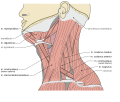Neck
Neck
The neck is the part of the body that separates the head from the torso. It contains various blood vessels and nerves that supply structures mainly in the head and neck. The neck is also involved in several important functions such as breathing, swallowing, and speaking.
Anatomy
The neck is made up of several structures including the vertebral column, nerves, muscles, and skin. The vertebral column in the neck is made up of seven bones called the cervical vertebrae. These bones protect the spinal cord and provide support for the head.
The neck also contains several muscles that are responsible for movement of the head and neck. These muscles include the sternocleidomastoid, trapezius, and the scalene muscles.
Function
The neck has several important functions. It supports the weight of the head and allows it to move in different directions. The neck also contains the larynx, which is involved in speech and swallowing. The thyroid gland, which is located in the neck, produces hormones that regulate metabolism.
Clinical significance
There are several medical conditions that can affect the neck. These include neck pain, whiplash, and thyroid disease. Neck pain can be caused by a variety of factors including poor posture, stress, and injury. Whiplash is a common injury that occurs when the neck is suddenly jerked back and forth. Thyroid disease can cause a variety of symptoms including fatigue, weight gain, and depression.
See also
References
Transform your life with W8MD's budget GLP-1 injections from $125.
W8MD offers a medical weight loss program to lose weight in Philadelphia. Our physician-supervised medical weight loss provides:
- Most insurances accepted or discounted self-pay rates. We will obtain insurance prior authorizations if needed.
- Generic GLP1 weight loss injections from $125 for the starting dose.
- Also offer prescription weight loss medications including Phentermine, Qsymia, Diethylpropion, Contrave etc.
NYC weight loss doctor appointments
Start your NYC weight loss journey today at our NYC medical weight loss and Philadelphia medical weight loss clinics.
- Call 718-946-5500 to lose weight in NYC or for medical weight loss in Philadelphia 215-676-2334.
- Tags:NYC medical weight loss, Philadelphia lose weight Zepbound NYC, Budget GLP1 weight loss injections, Wegovy Philadelphia, Wegovy NYC, Philadelphia medical weight loss, Brookly weight loss and Wegovy NYC
|
WikiMD's Wellness Encyclopedia |
| Let Food Be Thy Medicine Medicine Thy Food - Hippocrates |
Medical Disclaimer: WikiMD is not a substitute for professional medical advice. The information on WikiMD is provided as an information resource only, may be incorrect, outdated or misleading, and is not to be used or relied on for any diagnostic or treatment purposes. Please consult your health care provider before making any healthcare decisions or for guidance about a specific medical condition. WikiMD expressly disclaims responsibility, and shall have no liability, for any damages, loss, injury, or liability whatsoever suffered as a result of your reliance on the information contained in this site. By visiting this site you agree to the foregoing terms and conditions, which may from time to time be changed or supplemented by WikiMD. If you do not agree to the foregoing terms and conditions, you should not enter or use this site. See full disclaimer.
Credits:Most images are courtesy of Wikimedia commons, and templates, categories Wikipedia, licensed under CC BY SA or similar.
Contributors: Prab R. Tumpati, MD





